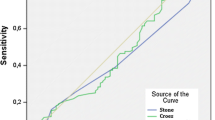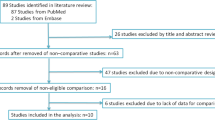Abstract
Introduction and objective
The aim of the present study was to compare the accuracy of the Guy’s and S.T.O.N.E. scoring systems in predicting percutaneous nephrolithotomy (PCNL) outcomes.
Methods
After obtaining ethics approval, medical records of patients undergoing PCNL between 2009 and 2013 at a tertiary stone center were retrospectively reviewed. Guy’s and S.T.O.N.E. scoring systems were calculated. Regression analysis and ROC curves were performed.
Results
A total of 185 PCNLs were reviewed. The overall stone-free rate was 71.9 % with a complication rate of 16.2 %. When compared to patients with residual fragments, stone-free patients had significantly lower Guy’s grade (2.7 vs. 2; p < 0.001) and S.T.O.N.E. score (8.3 vs. 7.4; p = 0.004). Logistic regression analysis showed that both Guy’s and S.T.O.N.E. systems were significantly associated with stone-free status, OR 0.4 (p < 0.001), and OR 0.7 (p = 0.001), respectively. Furthermore, both scoring systems were significantly associated with the estimated blood loss (p = 0.01 and p = 0.005). There was good correlation between both scoring systems and operative time (r = 0.3, p < 0.001 and r = 0.4, p < 0.001) and length of hospital stay (r = 0.2, p = 0.001 and r = 0.3, p < 0.001). However, there were no significant associations between both scoring systems and complications (p = 0.7 and p = 0.6). There was no significant difference in the areas under the curves for the Guy’s and S.T.O.N.E. scoring systems (0.74 [95 % CI 0.66–0.82] vs. 0.63 [95 % CI 0.54–0.72]; p = 0.06).
Conclusion
Both Guy’s and S.T.O.N.E scoring systems have comparable accuracies in predicting post-PCNL stone-free status. Other factors not included in either scoring system may need to be incorporated in the future to increase their accuracy.

Similar content being viewed by others
Abbreviations
- AUA:
-
American Urological Association
- AUC:
-
Area under curve
- BMI:
-
Body mass index
- CI:
-
Confidence interval
- EBL:
-
Estimated blood loss
- LOS:
-
Length of hospital stay
- NCCT:
-
Non-contrast computed tomography
- PCNL:
-
Percutaneous nephrolithotomy
- PCS:
-
Pelvi-calyceal system
- ORs:
-
Odds ratios
- ROC:
-
Receiver operating characteristic
References
Preminger GM, Assimos DG, Lingeman JE et al (2005) AUA guideline on management of staghorn calculi: diagnosis and treatment recommendations. J Urol 173(6):1991–2000
Mirheydar HS, Palazzi KL, Derweesh IH, Chang DC, Sur RL (2013) Percutaneous nephrolithotomy use is increasing in the United States: an analysis of trends and complications. Journal of endourology/Endourological Society 27(8):979–983
Opondo D, Gravas S, Joyce A et al (2014) Standardization of patient outcomes reporting in percutaneous nephrolithotomy. J Endourol 28(7):767–774. doi:10.1089/end.2014.0057
Thomas K, Smith NC, Hegarty N et al (2011) The Guy’s stone score-grading the complexity of percutaneous nephrolithotomy procedures. Urology 78(2):277–281
Vicentini FC, Marchini GS, Mazzucchi E et al (2014) Utility of the Guy’s stone score based on computed tomographic scan findings for predicting percutaneous nephrolithotomy outcomes. Urology 83(6):1248–1253
Ingimarsson JP, Dagrosa LM, Hyams ES et al (2014) External validation of a preoperative renal stone grading system: reproducibility and inter-rater concordance of the Guy’s stone score using preoperative computed tomography and rigorous postoperative stone-free criteria. Urology 83(1):45–49
Okhunov Z, Friedlander JI, George AK et al (2013) S.T.O.N.E. nephrolithometry: novel surgical classification system for kidney calculi. Urology 81(6):1154–1159
Okhunov Z, Helmy M, Perez-Lansac A et al (2013) Interobserver reliability and reproducibility of S.T.O.N.E. nephrolithometry for renal calculi. J Endourol 27(10):1303–1306
Shahrour W, Andonian S (2010) Ambulatory percutaneous nephrolithotomy: initial series. Urology 76:1288–1292
de la Rosette JJ, Opondo D, Daels FP, CROES PCNL Study Group et al (2012) Categorisation of complications and validation of the Clavien score for percutaneous nephrolithotomy. Eur Urol 62(2):246–255
Labadie K, Okhunov Z, Akhavein A et al (2014) Evaluation and comparison of urolithiaisis scoring systems in percutaneous kidney stone surgery. J Urol accepted. doi:10.1016/j.juro.2014.07.104
Mandal S, Goel A, Kathpalia R et al (2012) Prospective evaluation of complications using the modified Clavien grading system, and of success rates of percutaneous nephrolithotomy using Guy’s Stone Score: a single-center experience. Indian J Urol 28(4):392–398
Acknowledgments
This work was supported by Grants from Fonds de la Recherche en Santé du Québec (FRSQ) to Dr Sero Andonian.
Conflict of interest
All authors declare no conflict of interest.
Ethical standard
This study was conducted in accordance with the Declaration of Helsinki and its amendments after both Institutional Review Board (No. 14-050-GEN) and Director of Professional Services (McGill University Health Centre) approvals were obtained.
Author information
Authors and Affiliations
Corresponding author
Rights and permissions
About this article
Cite this article
Noureldin, Y.A., Elkoushy, M.A. & Andonian, S. Which is better? Guy’s versus S.T.O.N.E. nephrolithometry scoring systems in predicting stone-free status post-percutaneous nephrolithotomy. World J Urol 33, 1821–1825 (2015). https://doi.org/10.1007/s00345-015-1508-5
Received:
Accepted:
Published:
Issue Date:
DOI: https://doi.org/10.1007/s00345-015-1508-5




